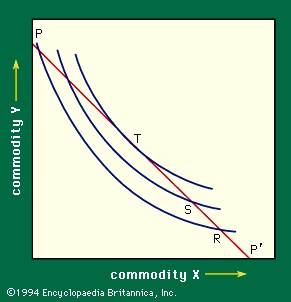indifference curve
economics
in economics, graph showing various combinations of two things (usually consumer goods) that yield equal satisfaction or utility to an individual. Developed by the Irish-born British economist Francis Y. Edgeworth (Edgeworth, Francis Ysidro), it is widely used as an analytical tool in the study of consumer behaviour, particularly as related to consumer demand. It is also utilized in welfare economics, a field that focuses on the effect of different actions on individual and general well-being.
 The classic indifference curve is drawn downward from left to right and convex to the origin, so that a consumer who is given a choice between any two points on it would not prefer one point over the other. Because all of the combinations of goods represented by the points are equally desirable, the consumer would be indifferent to the combination actually received. An indifference curve is always constructed on the assumption that, other things being equal, certain factors remain constant.
The classic indifference curve is drawn downward from left to right and convex to the origin, so that a consumer who is given a choice between any two points on it would not prefer one point over the other. Because all of the combinations of goods represented by the points are equally desirable, the consumer would be indifferent to the combination actually received. An indifference curve is always constructed on the assumption that, other things being equal, certain factors remain constant.- Bird, Robert Montgomery
- bird rug
- Birdseye, Clarence
- bird's-foot trefoil
- bird's-nest orchid
- birdsong
- bird stone
- bird-watching
- Birendra Bir Bikram Shah Dev
- biretta
- Birger Jarl
- Birger Magnusson
- Birger Ruud
- Birger Sjöberg
- Birgit Nilsson
- Birgitta Trotzig
- Biringuccio, Vannoccio
- biritch
- Birka
- Birkarlar
- Birkbeck, George
- Birkenhead
- Birkenhead, Frederick Edwin Smith, 1st Earl of, Viscount Furneaux Of Charlton, Viscount Birkenhead Of Birkenhead, Baron Birkenhead Of Birkenhead
- Birkenia
- Birkhoff, George David